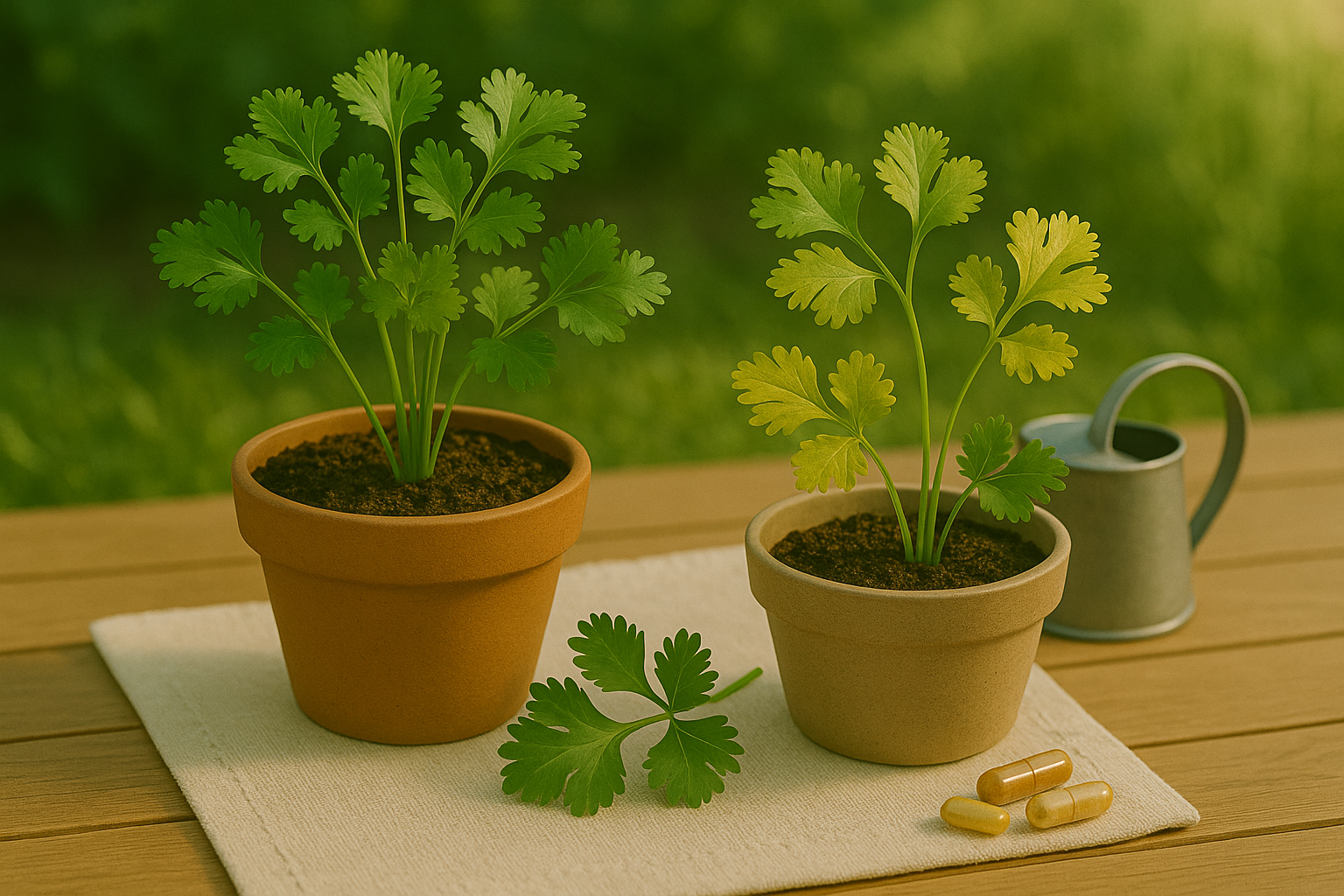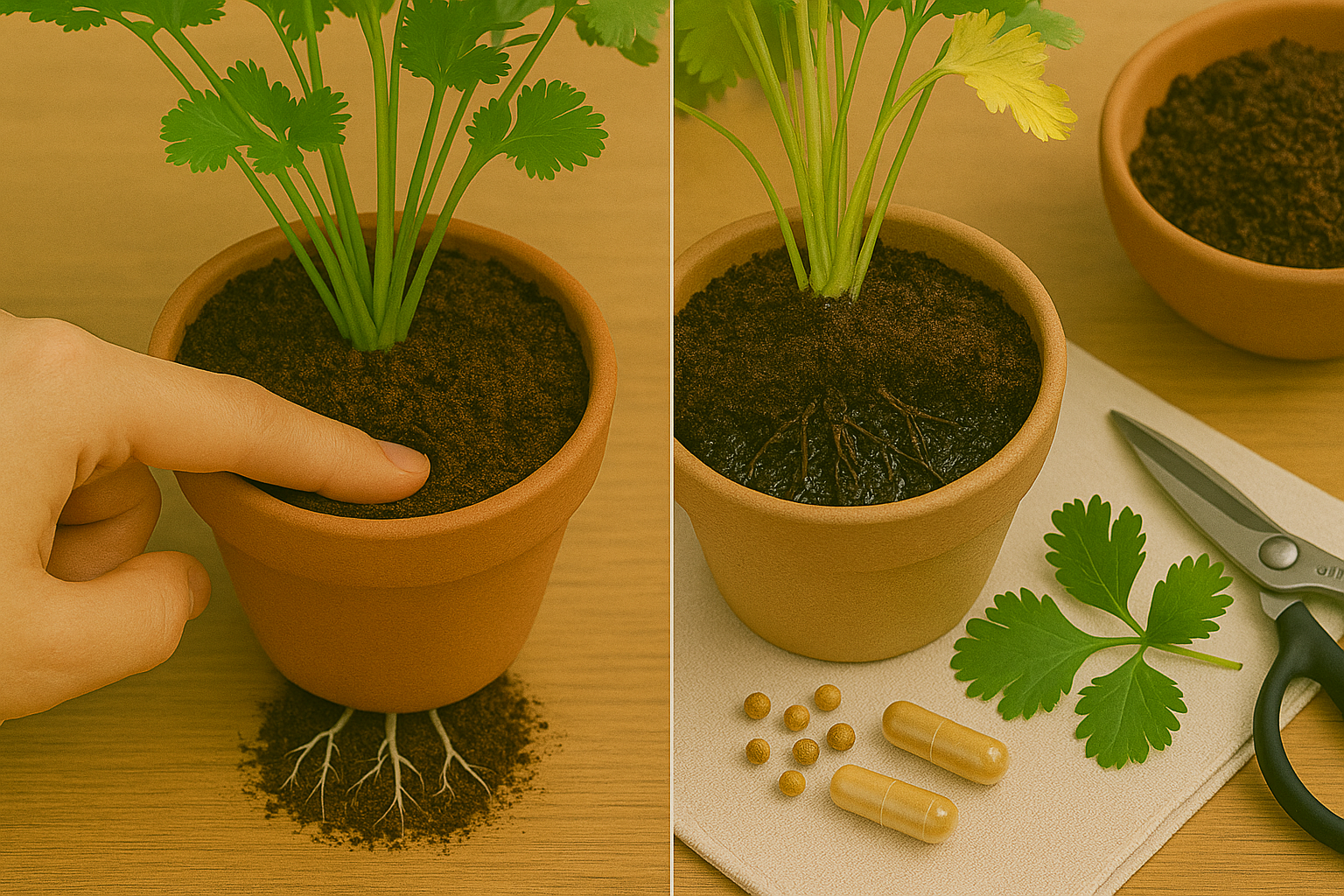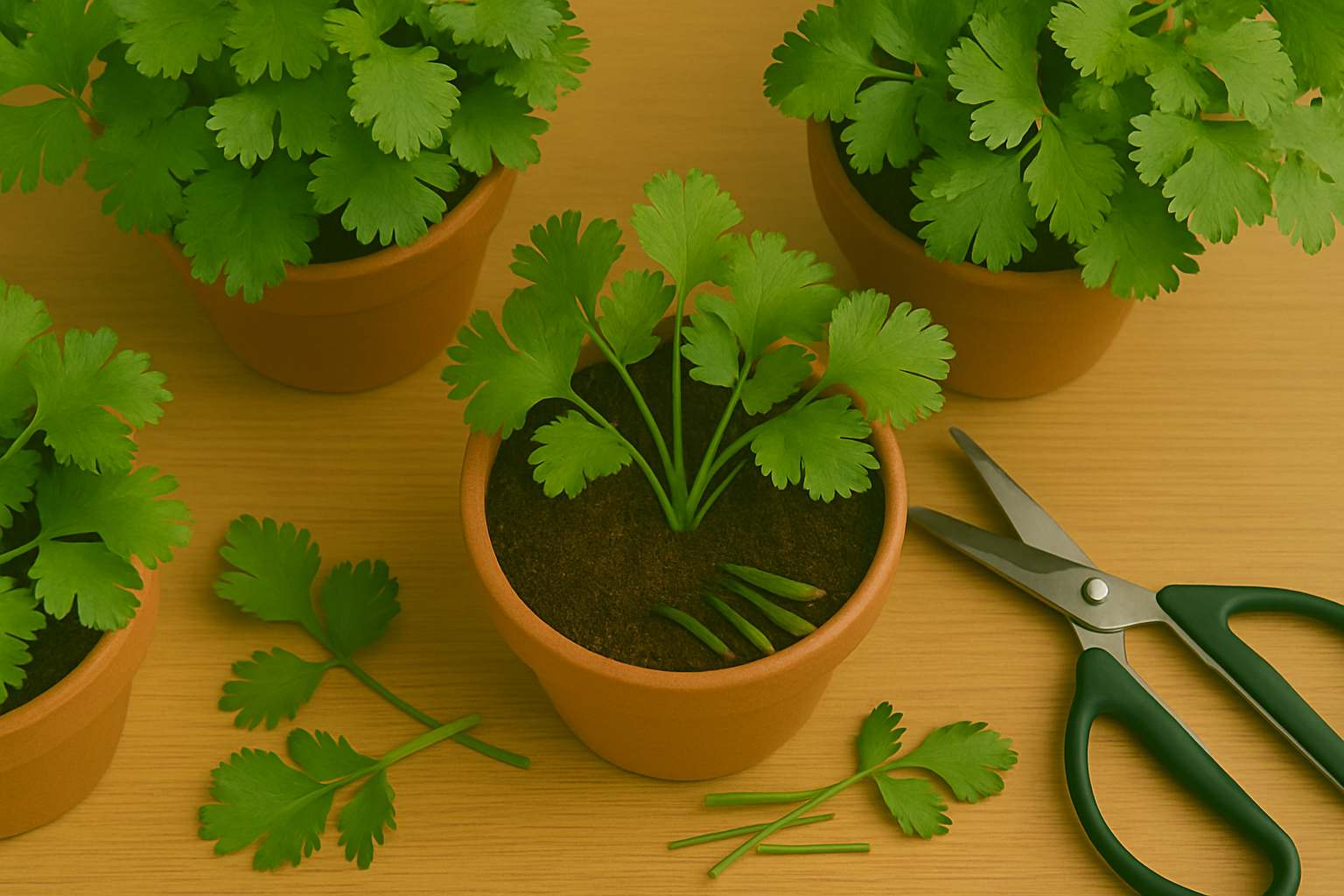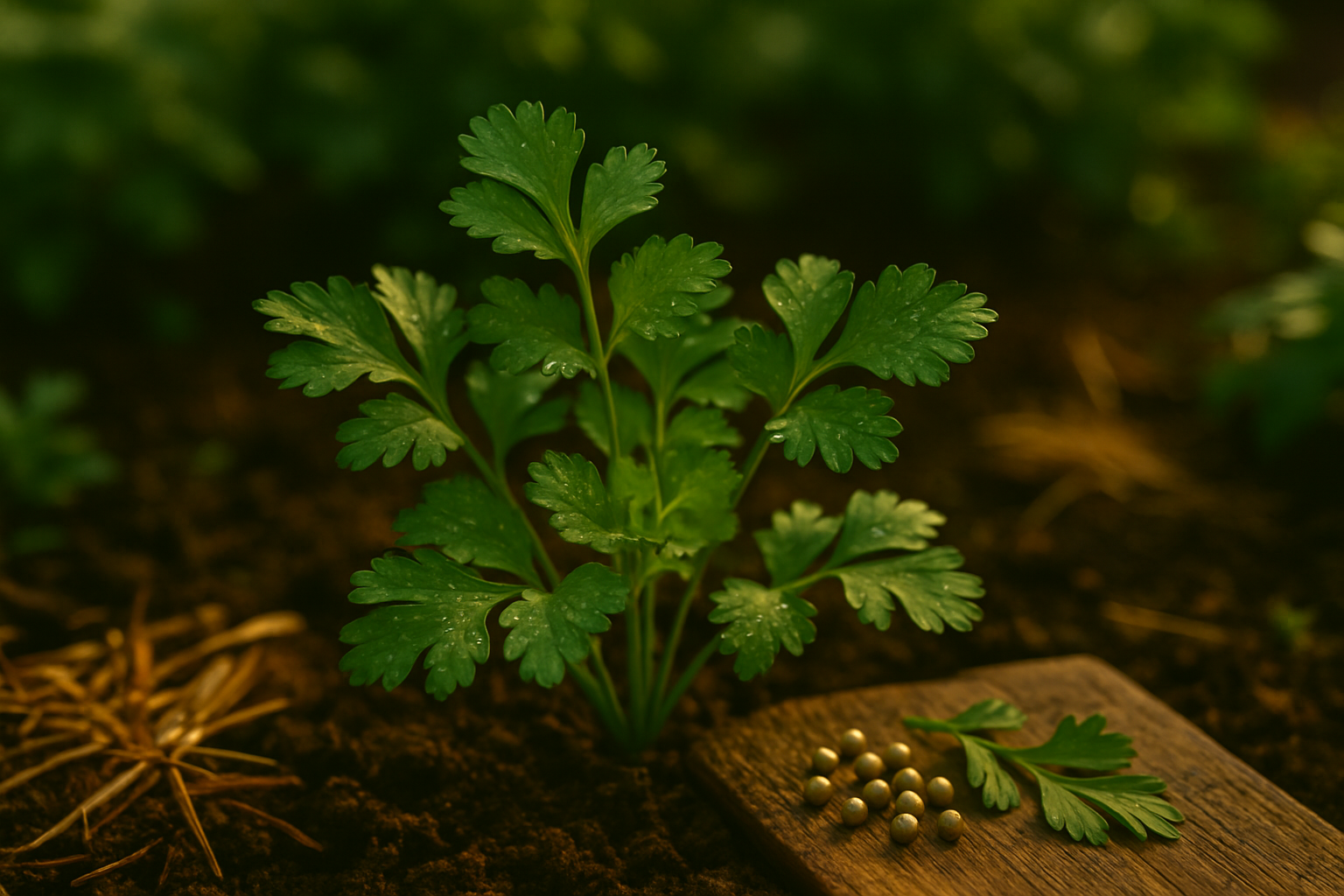Introduction
Curious about how often to water cilantro? Whether you’re growing this fragrant herb indoors on your kitchen windowsill or outside in a garden bed, getting the watering schedule right is key to lush, healthy leaves. Cilantro is a kitchen favorite, adding fresh flavor to everything from tacos to salads, but it’s also finicky about moisture.
Many beginners accidentally overwater and end up with droopy, yellowing plants, while others water too little and watch their cilantro wilt or bolt prematurely. Finding that sweet spot—keeping the soil consistently moist but never soggy—can be tricky, especially with changing seasons and different potting setups.
In this guide, we’ll break down exactly how often to water cilantro, share practical tips for different environments, and highlight signs to watch for if things go off track. By the end, you’ll feel confident in giving your cilantro the TLC it needs to thrive.
Understanding Cilantro’s Water Needs

Cilantro, known for its fresh, citrusy flavor, originates from regions bordering the Mediterranean and parts of southwestern Asia, where it thrives in well-drained soils with moderate rainfall. This background means cilantro craves consistent moisture—but not soggy conditions. Overwatering is just as problematic as letting the soil dry out.
Whether in the garden or containers, cilantro prefers evenly moist soil, ideally watered whenever the top inch feels dry to the touch. Drought stress causes cilantro’s leaves to droop, curl, and lose their vibrant green color, quickly turning a dull yellowish hue at the tips. On the flip side, too much water or waterlogged soil leads to yellowing leaves starting at the base and a mushy, rotten smell near the roots—often a sign of root rot.
To hit the sweet spot, water slowly and deeply at the soil level in the morning, allowing excess water to drain away. Mulching can help retain moisture, but always make sure the soil isn’t left soggy after rain or irrigation. If you notice new foliage staying perky and richly green, your watering routine is likely just right. If leaves look limp, faded, or discolored, adjust the frequency and check drainage.
Using these real-world cues makes it easier to dial in cilantro’s ideal water needs, supporting lush, flavorful growth through the season.
How Often Should You Water Cilantro?

Watering cilantro correctly is key to growing lush, flavorful leaves, and the right routine depends on where and how you grow it. For outdoor cilantro in gardens or beds, aim to water one to two times weekly, allowing the top inch of soil to dry between sessions—this often translates to about one inch of water per week, adjusted if rain falls.
In hot or dry climates, you may need to check soil moisture more frequently, especially during summer, as cilantro wilts quickly when thirsty. If your cilantro is potted (either outdoors or on a patio), pots tend to dry out faster: check the soil every day or two, watering whenever the top half-inch feels dry.
Indoor cilantro, where sunlight is gentler and conditions steadier, usually needs less water—water once a week as a baseline, lightly checking if leaves look droopy or soil feels parched earlier.
No matter where your cilantro grows, use the finger test: gently stick your finger an inch into the soil; if it feels dry or powdery, it’s time to water. Also, visually inspect the soil—if it appears cracked, pale, or pulling away from the pot edges, moisture is low.
For seedlings, keep soil consistently damp (like a wrung-out sponge) but never soggy to encourage strong root growth; mature plants tolerate minor drying out between waterings.
Create a Simple Schedule
- Outdoors: try Sundays and Thursdays on dry weeks
- For pots: set reminders to check soil every two days
- Indoors: make Wednesdays your plant check-in
Always adjust after heatwaves, heavy rain, or if your home’s humidity fluctuates. With these flexible routines and quick soil checks, your cilantro will thrive through every season.
Tips for Watering Cilantro Properly
Watering cilantro correctly can make all the difference between lush, healthy herbs and sad, wilted leaves. The best time to water cilantro is in the morning. This allows the plants to soak up moisture as the day warms, helping them stay hydrated without the risk of excess moisture sitting on leaves overnight, which can cause fungal diseases.
Use room-temperature water rather than ice-cold water; the latter can shock cilantro’s roots and slow its growth. Rainwater or filtered water is ideal, especially if your tap water is very hard or chlorinated, as cilantro prefers less mineral-heavy hydration.
When watering, direct the flow to the base of the plant and avoid getting the foliage wet; wet leaves can attract powdery mildew and other issues. A small watering can with a narrow spout works well for this purpose.
Make sure the soil stays consistently moist but not waterlogged—cilantro dislikes sitting in soggy ground. Mulching with straw, shredded leaves, or fine bark around the base of your plants helps retain moisture, moderate soil temperature, and reduce how often you’ll need to water.
In hot weather, check your cilantro daily; if the top inch of soil feels dry, it’s time to water. Pair these steps with well-draining soil, and your cilantro will thrive, producing fresh, flavorful leaves for salads, salsas, and more.
Common Watering Problems and How to Fix Them

Overwatering and underwatering are two of the most common issues that can wreak havoc on houseplants and gardens alike. Overwatered plants often exhibit yellowing leaves, mushy stems, or even root rot—a condition where the roots turn brown, smell foul, and become slimy due to a lack of oxygen and fungal growth. On the other hand, underwatered plants typically show dry, crispy leaves, drooping stems, and soil that pulls away from the edges of the pot.
If you notice wilting but the soil feels wet, that’s a sign of overwatering; if the soil is bone dry, it’s likely underwatering. One practical fix for root rot is to gently remove the plant from its pot, trim away mushy or blackened roots with sterilized scissors, and replant in fresh, dry soil.
For ongoing prevention, amend your soil with coarse sand, perlite, or small bark chips to improve drainage. Make sure pots have drainage holes to prevent water from pooling at the bottom. Water only when the top inch of soil feels dry, and try bottom watering by placing the pot in a tray of water for ten minutes—this encourages roots to reach downward.
Keeping a consistent watering schedule and monitoring soil moisture can help prevent these common issues, ensuring your plants stay healthy and resilient.
Cilantro Care Beyond Watering
Caring for cilantro goes far beyond simply keeping the soil moist. This herb thrives with 4–6 hours of direct sunlight daily, ideally in a spot that receives gentle morning sun but is shielded from harsh afternoon rays. Choose loose, well-draining soil rich in organic matter—compacted soil can lead to root rot, especially when combined with overwatering.
Fertilize every 3–4 weeks with a balanced liquid fertilizer to support leafy growth, but don’t overdo it; too much fertilizer can cause cilantro to bolt, making the leaves bitter. Each of these factors is closely tied to your watering routine: poor drainage or excess water suffocates roots, while insufficient light and nutrients can stunt growth no matter how well you water.
For easy, ongoing care, use this checklist:
- Place in partial but direct sunlight
- Keep soil loose and rich in compost
- Water when the top inch of soil is dry
- Fertilize lightly every few weeks
- Trim leaves regularly to encourage new growth
- Check for pests and remove any yellowing leaves
By balancing these needs, you’ll keep your cilantro lush and flavorful all season long.
Harvesting and Extending Cilantro’s Life

To get the most out of your cilantro plants, start harvesting leaves when the plant is about 6 inches tall and before it bolts (sends up flower stalks). Use clean, sharp scissors to snip individual outer stems or leaves about an inch above the soil, leaving the central growth point intact. This helps minimize stress and encourages the plant to keep producing new foliage.
Always avoid cutting more than one-third of the plant at any time, as over-harvesting can stunt growth. Right after harvesting, water your cilantro thoroughly, but don’t let the soil get soggy. Consistent, moderate moisture helps plants recover and boosts their productivity.
If you notice the plant starting to flower, pinch off the flower heads to delay bolting and prolong your harvests. For a steady supply of fresh cilantro, practice succession planting: sow new seeds every two to three weeks, either in your garden or in pots.
You can also try regrowing cilantro by placing harvested stem cuttings in a glass of water until they sprout roots, then transplanting them back into soil. These strategies let you enjoy lush cilantro all season long and keep your kitchen stocked with flavorful, homegrown herbs.
Conclusion
Watering cilantro may seem simple, but getting it right makes all the difference for healthy, flavorful leaves. Remember to keep the soil consistently moist but not soggy, adjust your watering schedule based on weather and pot size, and always check the soil before adding more water.
Every growing environment is unique, so observe how your cilantro responds and tweak your approach as needed. Don’t be afraid to experiment a little to find what works best in your space.
Have tips, struggles, or questions? Share your experiences in the comments below—we’d love to hear from fellow cilantro growers!
